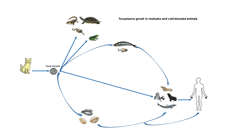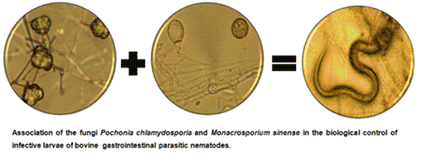Review Article
Toxoplasma gondii in mollusks and cold-blooded animals: a systematic review
-
- Published online by Cambridge University Press:
- 11 March 2021, pp. 895-903
-
- Article
- Export citation
Research Article
Influence of colony traits on ectoparasite infestation in birds breeding in mixed-species colonies
-
- Published online by Cambridge University Press:
- 17 March 2021, pp. 904-912
-
- Article
-
- You have access
- HTML
- Export citation
Molecular characterization of Cysticercus tenuicollis isolates from sheep in the Nile Delta, Egypt and a review on Taenia hydatigena infections worldwide
-
- Published online by Cambridge University Press:
- 29 March 2021, pp. 913-933
-
- Article
- Export citation
Establishment of suitable reference genes for studying relative gene expression during the transition from trophozoites to cyst-like stages and first evidences of stress-induced expression of meiotic genes in Trichomonas vaginalis
-
- Published online by Cambridge University Press:
- 08 April 2021, pp. 934-946
-
- Article
- Export citation
Functional traits shape small mammal-helminth network: patterns and processes in species interactions
-
- Published online by Cambridge University Press:
- 21 April 2021, pp. 947-955
-
- Article
-
- You have access
- Open access
- HTML
- Export citation
In vitro compatibility and nematicidal activity of Monacrosporium sinense and Pochonia chlamydosporia for biological control of bovine parasitic nematodes
-
- Published online by Cambridge University Press:
- 26 April 2021, pp. 956-961
-
- Article
- Export citation
Deep in the systematics of Camallanidae (Nematoda): using integrative taxonomy to better understand the phylogeny and consistency of diagnostic traits
-
- Published online by Cambridge University Press:
- 03 May 2021, pp. 962-974
-
- Article
- Export citation
Systemic efficacy on Cryptosporidium parvum infection of aminoxanide (RM-5061), a new amino-acid ester thiazolide prodrug of tizoxanide
-
- Published online by Cambridge University Press:
- 29 March 2021, pp. 975-984
-
- Article
- Export citation
Historical contingency, geography and anthropogenic patterns of exposure drive the evolution of host switching in the Blastocystis species-complex
-
- Published online by Cambridge University Press:
- 29 March 2021, pp. 985-993
-
- Article
- Export citation
Angiostrongylus cantonensis in urban populations of terrestrial gastropods and rats in an impoverished region of Brazil
-
- Published online by Cambridge University Press:
- 12 April 2021, pp. 994-1002
-
- Article
- Export citation
Helminth communities of endemic cyprinoids of the Apennine Peninsula, with remarks on ectoparasitic monogeneans, and a description of four new Dactylogyrus Diesing, 1850 species
-
- Published online by Cambridge University Press:
- 12 April 2021, pp. 1003-1018
-
- Article
-
- You have access
- Open access
- HTML
- Export citation
Front Cover (OFC, IFC) and matter
PAR volume 148 issue 8 Cover and Front matter
-
- Published online by Cambridge University Press:
- 10 June 2021, pp. f1-f2
-
- Article
-
- You have access
- Export citation
Back Cover (IBC, OBC) and matter
PAR volume 148 issue 8 Cover and Back matter
-
- Published online by Cambridge University Press:
- 10 June 2021, pp. b1-b2
-
- Article
-
- You have access
- Export citation












